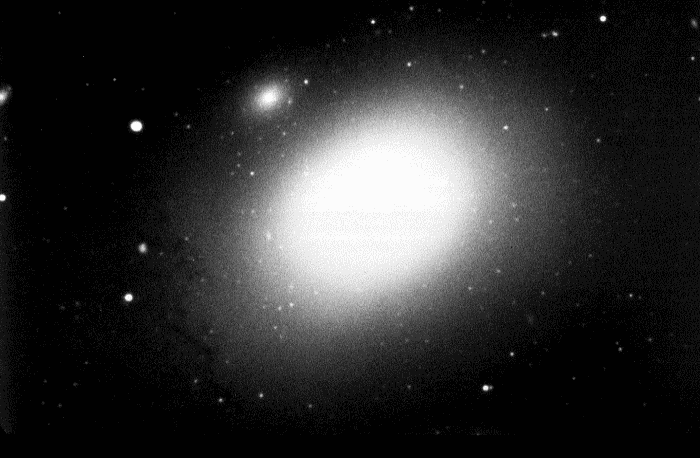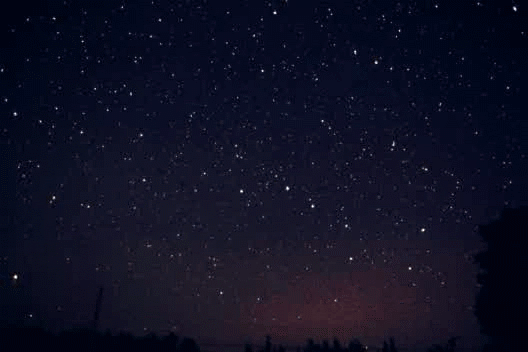| Types of Galaxies Key points: Basic types of galaxy - spiral, barred,
elliptical, irregular; types vs. distance (how young galaxies differ from those around us)
Spiral galaxies are the most intriguing visually,
But in fact galaxies come in many shapes and sizes.
|
 |
Galaxy shapes have 3 broad categories:
spirals , ellipticals, irregulars
, ellipticals, irregulars
Ellipticals -- can range from spherical to elongated,
football-like shapes
 |
 |
| Picture of an elliptical galaxy (M87, the giant
elliptical at the center of the nearby Virgo cluster of galaxies (about 15 million parsecs
away): |
A more "elliptical" elliptical, M86 |
Irregulars -- catchall type for galaxies without symmetric
shapes
 |
Picture of an irregular galaxy, the Large Magellanic Cloud, at 55
thousand parsecs one of the two closest galaxies to the Milky Way (and possibly in the
process of merging with us!) (from http://www.astro.columbia.edu/~neill/astron/) |
Note the following systematic trends:
1) Interstellar material ranges from essentially none in ellipticals to
substantial quantities in some irregulars
2) Ellipticals have low to zero rotation rates while spirals have relatively high
rotation rates
3) The most massive galaxies are ellipticals with some irregulars being very small
("dwarfs"). Spirals tend to be intermediate in size.
We use the local group spiral galaxy M31 to help visualize galaxies across the
electromagnetic spectrum (Images are from Beck et al. (radio), Thilker et al.
(HI), S. Muller (CO), Deevereux (H alpha), MIPS team (far and mid infrared), 2MASS (near
infrared), APOD - J. Ware (visible) GALEX (ultraviolet), and ROSAT (x-ray).
 |
Here, we run through the entire spectrum starting with the radio
and ending in the X-ray. The spiral arms are strong for radio through mid-infrared,
and in the ultraviolet, and in ionized gas, all of which respond strongly to recent star
formation.They also show clearly in molecular gas, which is the fuel for forming stars. In
the near infrared, the image is dominated by old stars in the bulge, and the spiral arms
are almost invisible. In the x-ray, we see massive double stars left over from previous
episodes of star formation. The atomic gas and to some extent the far infrared spread far
beyond the regions of the spiral arms and galaxy disk. There is also a component of
ionized gas in the nuclear region. Thus, the types of gas have very different
distributions, and most of the star formation is well separated from the older stars.
(animation by G. Rieke) |
The most distant galaxies - are they the same
types as nearby ones?
 |
Under the leadership of former UA professor Bob Williams, the
Hubble Space Telescope spent many days observing a small region just above the Big Dipper.
The "Hubble Deep Field", or "HDF", is just a point to our unaided
eyes. Here we zoom in by a factor of 1000 to get a look. The total area of the HDF is
about 1% that of the full moon. (From STScI) |
 |
At first glance, the HDF shows more and
more faint galaxies just like the nearby ones. If we look at the ones at the highest
redshift, they seem subtly different -- many are small, like pieces of the large nearby
galaxies. This behavior reminds us of the models of the early Universe, where galaxy
fragments formed first and only later merged into large galaxies. |
 |
However, there is no sign of an
"end" to the galaxies -- we have found them to redshift (z) of 7, when the
Universe was only about 750 Million years old! Here is an example that benefits from being
amplified by gravitational lensing by the massive cluster Abell 2218. The red line in the
top picture is a line of symmetry for lensed images of background galaxies at redshift z =
7. The red arclets imaged on either side and circled as a and b are images of a background
galaxy at z about 6.7. These images are amplified by a factor of 20 to 30 by the cluster
and still are very faint! You can see them better in the two inset pictures at the bottom,
where they are again in red. An even fainter image is shown in inset c (again in red). |










